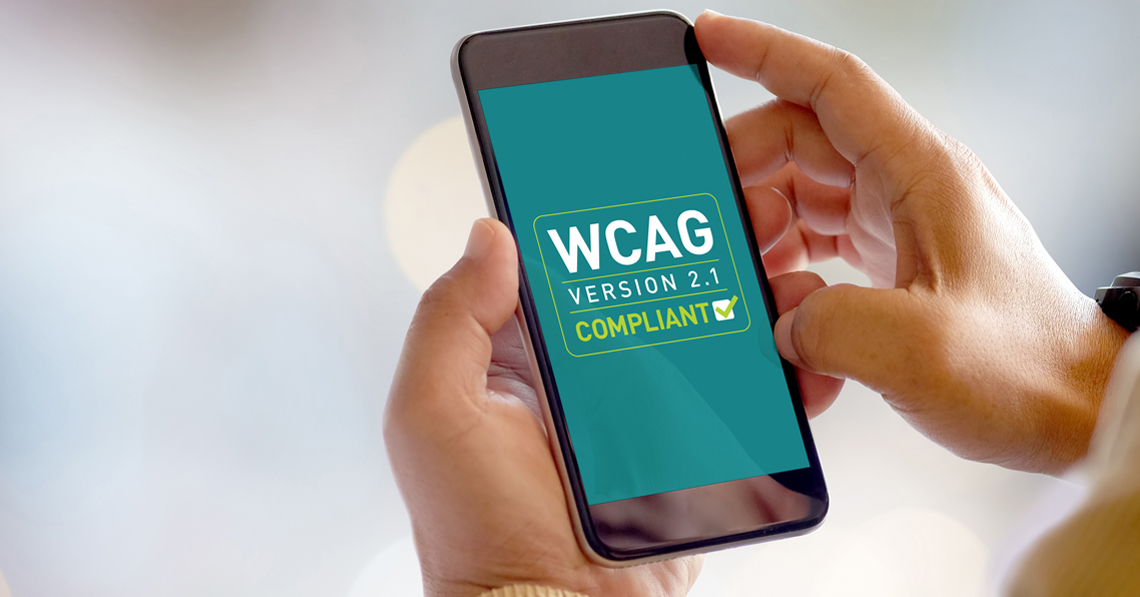In our Plain Talk article earlier this year, Can your website land you in court? Making your website ADA accessible, we discussed a few reasons why businesses should consider upgrading their website accessibility for people with disabilities. At that time, a flood of discrimination lawsuits were hitting the courts that related to Title III of the Americans with Disabilities Act (ADA), and we recommended that if your business had a physical location and a website, you should “probably” make it WCAG 2.1 compliant to meet contemporary recommended standards for accessibility. In this edition of our Plain Talk series, we’ll be upgrading that “probably” to a “definitely” and explaining what’s changed and how it may impact you and your business.
What is WCAG 2.1?
As a refresher, WCAG stands for “Web Content Accessibility Guidelines,” and today version 2.1 reflects the recommended level of accessibility that websites should achieve to best serve users with disabilities. These standards are created and updated by the organization W3C in collaboration with others. WCAG 2.1 sets out 38 success requirements for websites to meet the AA accessibility rating (the gold standard for accessibility).
What’s changed in 2019?
Plenty. In January 2019, the Ninth Circuit Court of Appeals in California ruled that the Americans with Disabilities Act applied to websites in a case between Guillermo Robles and Domino’s Pizza, LLC. In this case, Robles, who is legally blind, sued Domino’s in Los Angeles because their website lacked the ability for his screen reader to access it. Robles’ attorneys successfully argued that Title III of the ADA applied to websites and web apps.
As happens in lawsuits, Domino’s appealed the case to the US Supreme Court. In October 2019, the US Supreme Court refused to review the Ninth Circuit Court’s decision in Robles v. Domino’s Pizza, LLC, kicking the case back to the 9th Circuit. While the fight continues, the US Supreme Court and 9th Circuit have sent strong signals to businesses, putting them on notice that the courts are growing tired of businesses that ignore ADA Title III accessibility.
The implications are that Title III of the Americans with Disabilities Act is being interpreted to mean that websites must make the best effort (see WCAG 2.1) to offer services to people with disabilities.
Is Robles v Domino’s Pizza, LLC a big deal?
How big is this case? Big. Really big. So big in fact that both Robles and Domino’s have loads of legal help. On Robles’ side, that help includes advocacy groups like the National Federation of the Blind, the American Council of the Blind, the Association of Late Deafened Adults, the National Association of the Deaf, the National Disability Rights Network, the World Institute on Disability, and many more.
On Domino’s side, there are dozens of professional associations including the U.S. Chamber Litigation Center, the American Bankers Association, the American Hotel & Lodging Association, the American Resort Development Association, the National Federation of Independent Business Small Business Legal Center, the International Council of Shopping Centers, the National Association of Home Builders, and others. In this one case, the forces legally representing disabled Americans and businesses have squared off on the issue of web accessibility, and the disabled have, so far, emerged the big winners.
How does this affect me?
While undoubtedly there is much more litigation in the future on this issue, there’s a clear path for businesses who want to avoid the potential expense and brand harm of a nasty, public lawsuit. Just fix it. If you’re in a line of business like those whose associations came to the aid of Domino’s, you should immediately form a plan to make sure that your website meets the guidelines laid out in WCAG 2.1. Not only is it the right thing to do for your disabled customers, it’s also the best way to protect your business from the wave of similar suits popping up in courts across the country.
Already over the past several years, the number of ADA-accessibility-related lawsuits has increased dramatically and touched virtually all of these industries. For example, a recent article in BankersOnline.com noted that between 2018 and the article’s posting date in 2019, 147 banks had been sued for ADA compliance issues and “the trend shows no sign of slowing down.”
The Ninth Circuit Court’s decision essentially says that Title III of the ADA is applicable to websites when there is a connection between the website and a physical place (e.g. banks, restaurants, hotels, and so on). If that’s you, it’s time to get your site compliant.
What if my business doesn’t have a “physical place?”
The 9th Circuit’s decision did not address stand-alone e-commerce websites, however there are dozens of cases pending in courts across the United States. Well-known e-brands like eyeglass e-tailer Warby Parker and cult beauty brand Glossier have been recently sued. In response to the Glossier suit, the Council of Fashion Designers of America posted an article by attorney Michael Adams advising that among other things “A business can minimize the risk and achieve the best possible position to defend itself against an ADA web accessibility claim by taking these steps: Conducting an ADA compliance audit of its website and digital content, and engaging a vendor to help bring its website into compliance with [WCAG] guidelines.” We think that’s pretty solid advice.
Why is there so much confusion on ADA?
While the Department of Justice states that the ADA has applied to websites since 1996, clear written standards and enforcement have been pretty much non-existent. It’s this lack of Federal standards on web accessibility that has led many companies to take a wait-and-see approach to their web practices. However, it seems clear today that WCAG or something very close is likely to become the Federal standard. Already WCAG has been adopted as the Federal standard by the Department of Transportation in the form of new digital accessibility regulations under the Air Carrier Access Act and updates to the Rehabilitation Act of 1973 that, among other things, require WCAG to be the standard for all Federal agency websites. Many believe that the time is coming soon when the ADA is officially amended to include WCAG language, but in the meantime, it’s clear that the courts are leaning on WCAG as the best practice that should be followed.
There’s a lot more to know about web accessibility. If you have any questions and would like to talk to one of PriceWeber’s digital experts, we hope you’ll contact us by email or give us a call at 502-499-4209, and we’ll be happy to help.


